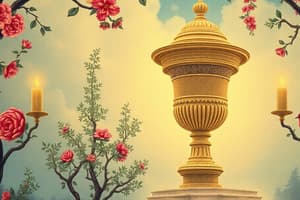Podcast
Questions and Answers
What does the urn symbolize for the speaker?
What does the urn symbolize for the speaker?
- A connection to human emotions (correct)
- A reminder of past failures (correct)
- A representation of eternal beauty and truth (correct)
- A testament to artistic limitations (correct)
What aspect of the figures on the urn fascinates the speaker?
What aspect of the figures on the urn fascinates the speaker?
- Their detailed clothing
- Their static nature
- Their potential identities and actions (correct)
- Their expressions of happiness
How does the speaker perceive the music associated with the urn?
How does the speaker perceive the music associated with the urn?
- As superior because it is unheard (correct)
- As less important than the visual art
- As a catalyst for memory
- As a source of overwhelming sadness
What imagery is used to portray the relationship of the two young lovers on the urn?
What imagery is used to portray the relationship of the two young lovers on the urn?
In what year was 'Ode on a Grecian Urn' written?
In what year was 'Ode on a Grecian Urn' written?
Flashcards are hidden until you start studying
Study Notes
Ode on a Grecian Urn: Summary & Analysis
- The poem is a direct address to a Grecian urn, praising its beauty and stillness, which surpasses the speaker's own time.
- The urn depicts scenes of a rural life in ancient Greece, provoking questions about the identities of the figures, the narrative of the scenes, and the overall significance of the depicted events.
- The speaker expresses a sense of wonder and amazement at the urn's ability to capture a moment of time forever.
- The repeated images of a piper, lovers, trees, and a ceremony underscore the theme of eternal stasis — the figures on the urn cannot age or move, but remain forever frozen in their actions.
- The contrast between the eternal beauty of the urn's scenes and the transient nature of human life is a core theme in Keats' ode.
- The speaker recognizes the urn as a symbol of beauty that can be interpreted in different ways by different generations.
- The poem's ending suggests that the urn embodies a fundamental truth, which is that beauty and truth are inseparable.
- Keats' poem explores themes of art, time, memory, beauty, and the nature of reality.
Studying That Suits You
Use AI to generate personalized quizzes and flashcards to suit your learning preferences.




